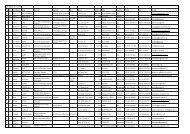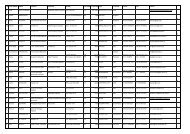icvg 2009 part I pp 1-131.pdf - Cornell University
icvg 2009 part I pp 1-131.pdf - Cornell University
icvg 2009 part I pp 1-131.pdf - Cornell University
You also want an ePaper? Increase the reach of your titles
YUMPU automatically turns print PDFs into web optimized ePapers that Google loves.
— 37 —<br />
viruses multiple primers and/or probes) were designed from<br />
regions to cover 100% consensus to ensure the detection of<br />
all or at least the majority of diverse isolates of each virus.<br />
Low-density PCR array analysis: To facilitate highthroughput<br />
analysis of larger numbers of samples, primer<br />
and TaqMan® probe mixes for 13 viruses and the 18s<br />
rRNA [universal plant 18S rRNA used as quality control in<br />
the assay] were dried onto the plastic surface of 384-well<br />
plates. Per assay, 5 µl volume of each 400nM primer and<br />
80nM of the corresponding TaqMan® probe was spotted<br />
into 384-well plates. The plates were divided vertically for<br />
the screening of 29 grapevine samples in one 384-well<br />
plate. After spotting the liquid was evaporated in a<br />
controlled 37C chamber on a Drierite bed (Hammond,<br />
Xenia, Ohio, USA) overnight. The spotted plates were then<br />
sealed and stored at 4 C with absorbent pouches. For realtime<br />
TaqMan® PCR analysis of the LDA plate, cDNA was<br />
used as the starting template which was synthesized from<br />
20 µl of total RNA prepared by method 3 mixed with 100<br />
units of SuperScript III (Invitrogen), 600 ng random<br />
hexamere, 10 U RNaseOut (RNase inhibitor), and 1mM<br />
dNTPs in a final volume of 40 µl.<br />
The reverse transcription reaction was for 120 min at<br />
50C followed by addition of 60 µl of water. The reaction<br />
was terminated by heating for 5 min at 95 C and cooling<br />
on ice. For LDA assay, 40 µl of cDNA was mixed with 40<br />
µl of 2× Universal TaqMan® Mastermix (A<strong>pp</strong>lied<br />
Biosystems) and 5µl of this mixture was a<strong>pp</strong>lied to a<br />
vertical row containing the 14 spotted primer and probe<br />
mixes (13 grapevine viruses and one 18s plant rRNA). The<br />
liquid was deposited to the walls of the 384-well positions,<br />
the plate was sealed with optical seal (A<strong>pp</strong>lied Biosystems)<br />
and had a quick spun in a centrifuge. The real-time<br />
TaqMan® RT-PCR analysis was performed in a 7900 HTA<br />
(A<strong>pp</strong>lied Biosystems) using the default cycling conditions 2<br />
min at 50 C, 10 min at 95 C, 40 cycles of 15 s at 95 C<br />
and 60 s at 60 C. All experiments included positive<br />
controls for the viruses under study and a negative control.<br />
by conventional RT-PCR (Table 1). Quantification of the<br />
viruses is also possible by TaqMan® RT-PCR either in<br />
extracts of total plant RNA or in crude extract (Osman et<br />
al., 2006). The 18S rRNA used in TaqMan® PCR assay<br />
was designed as an internal ‘RNA specific’ control for<br />
testing the purity of the RNA used as templates.<br />
Table 1. Results of RT-PCR, TaqMan ® RT-PCR and Low Density<br />
Arrays LDA. GLRaV-1 to -9 are referred to as LR1-9, GLRaV-<br />
2RG is refered to as Redglobe, RSPaV is referred to as RSP,<br />
GFkV is referred to as FLK. The C r values are of the RNA<br />
extracted by 2XAB and detected by LDA using the 18SrRNA<br />
TaqMan ® assay<br />
Grape Varieties RT-PCR TaqMan RT-PCR<br />
LOW DENSITY ARRAYS using<br />
2X AB RNA<br />
18S rRNA<br />
1 Cabernet Franc RSP RSP, FLK, GVA 19.17 LR2, RSP, FLK, GVA<br />
2 Peloursin LR2, GVB LR2, RSP, FLK, GVB 18.55 LR2, FLK, RSP, GVB<br />
3 Peloursin LR2, LR5, GVB LR2, LR5, GVA, GVB, TORSV 15.98 LR2, LR5, RSP, FLK, GVA, GVB, TORSV<br />
4 Csersz. Fusz. LR2, LR5, RSP LR2, LR5, RSP, FLK 20.17 LR2 LR5, RSP, FLK, GVA<br />
5 Korona LR1, GVA, RSP, FLK LR1, RSP, FLK, GVA 18.7 LR1, RSP, FLK, GVA<br />
6 Cab. Sauvignon LR1, LR2, RSP, FLK, GVA LR1, LR2, RSP, FLK, GVA 17.53 LR1, LR2, RSP, FLK, GVA<br />
7 Cab. Sauvignon LR2, RSP, FLK LR2, RSP, FLK 16.83 LR2, RSP, FLK<br />
8 Cab. Sauvignon LR2, LR1, RSP,FLK LR1, LR2, RSP, FLK 14.17 LR1, LR2, RSP, FLK, GVB<br />
9 Clairette Blanche LR3, RSP, FLK LR2, LR3, LR5, LR9, RSP,FLK 19.93 LR2, LR3, LR5, LR9, RSP,FLK<br />
10 Picardin LR2, LR5, RSP, FLK LR2, LR3, LR5, RSP, FLK, GVA,<br />
12.54 LR2, LR3, LR5, RSP, FLK, GVA, GVB,<br />
GFLV<br />
GFLV<br />
11 Cinsaut LR2, RSP, FLK, GVB LR2, RSP, FLK, GVB 12.27 LR2, RSP, FLK, GVB, GFLV<br />
12 Picpoul Blanc LR2, LR3, RSP, FLK, GVB LR2, LR3, RSP, FLK, GVB 16.15 LR2, LR3, RSP, FLK, GVB<br />
13 Muscardin LR2, RSP, FLK LR2, RSP, FLK, GVB 11.54 LR2, RSP, FLK, GVB<br />
14 Vaccarese LR2, RSP, FLK LR2, RSP, FLK 15.78 LR2, RSP, FLK<br />
15 Bourboulenc LR2,GVB LR2, RSP, FLK, GVA, GVB 13.75 LR2, RSP, FLK, GVA, GVB<br />
16 Assirtico LR2, RSP, GVB LR2, RSP, GVB 15.55 LR2, RSP, FLK, GVB<br />
17 Fileri LR2, LR3, GVB LR2, LR3, RSP, FLK, GVB 10.99 LR2, LR3, RSP, FLK, GVB<br />
18 Moschardina LR2, LR3, GVA LR2, LR3, RSP, GVA, GVB 12.39 LR2, LR3, RSP, FLK, GVA, GVB<br />
19 Cortese RSP, GVA, GVB LR2, RSP, GVB, GVA 17.26 LR2, LR9, RSP, GVA, GVB<br />
20 Triplett 181-7A LR3 LR3, RSP, GVB 16.87 LR3, RSP, GVB<br />
21 Fiesta 01 RSP, GVB, Redglobe RSP, GVB, Redglobe 18.57 FLK, RSP, GVB, Redglobe<br />
22 1307L LR2, FLK, GVB LR2, FLK, GVB 15.63 LR2, FLK, GVB<br />
23 Albarino FLK, GVB RSP, FLK, GVB 16.37 RSP, FLK, GVB<br />
24 IP-130 LR3, RSP, GVA LR3, RSP, GVA, GVB 16.53 LR3, RSP, GVA, GVB<br />
25 Adjem Misquet LR1, LR5, GVA LR5, RSP, GVA, GVB, GFLV 18.14 LR1, LR5, RSP, GFLV, GVA, GVB<br />
26 A<strong>pp</strong>ley Tower LR1, LR3, LR5, GVA LR1, LR2, LR3, LR5, LR9,<br />
18.3 LR1, LR2, LR3, LR5, LR9, RSP, GVA, GVB,<br />
RSP, GVA, GVB, GFLV<br />
GFLV<br />
27 Chaush White GVA RSP, GVA 19.08 RSP, Fleck, GVA, GVB<br />
28 Damas Rose LR2, LR3, LR5, RSP, GVA, GVB LR2, LR3, LR5, RSP, GVA, GVB 18.54 LR2,LR3, LR5, RSP, GVB, GVA, FLK<br />
29 Estellat LR1, LR2, RSP, GVA,GVB LR1, LR2, LR5, RSP, GVB, GVA 15.91 LR1,LR2, LR3, LR5, RSP, GVA, GVB<br />
Table 1. Results of RT-PCR, TaqMan ® RT-PCR and Low Density Arrays LDA. GLRaV-1 to -9 are refered to as LR1-9, GLRaV-2 RG is refered to as<br />
Comparisons were also made between the<br />
conventional one step RT-PCR and real-time TaqMan®<br />
PCR for the detection of these viruses using four fold serial<br />
dilutions of both purified RNA and crude extract. Results<br />
showed that real-time TaqMan® RT-PCR was more<br />
sensitive and could detect viruses at 32 and 256 fold higher<br />
dilutions for purified RNA and crude extract, respectively,<br />
compared to RT-PCR.<br />
RESULTS AND DISCUSSION<br />
To improve further the diagnostic method, the very<br />
sensitive, high capacity LDA system was investigated for<br />
the simultaneous detection of several viruses in infected<br />
grapevines. In this study the LDA CT values were<br />
compared with results obtained from conventional RT-PCR<br />
and real-time TaqMan® RT-PCR. It was found that realtime<br />
RT-PCR using LDA yielded the most reliable and<br />
reproducible data and the TaqMan® RT-PCR was the next<br />
most reliable method.<br />
The designed TaqMan® RT-PCR assays and LDA had<br />
a broad detection range for virus isolates collected from<br />
wide geographical regions where many were undetectable<br />
LITERATURE<br />
OSMAN, F. & ROWHANI, A, 2006. A<strong>pp</strong>lication of a spotting sample<br />
preparation technique for the detection of pathogens in woody<br />
plants by RT-PCR and real-time PCR (TaqMan). Journal of<br />
Virological Methods 133, 130-36.<br />
OSMAN, F., LEUTENEGGER, C., GOLINO, D. & ROWHANI, A.<br />
2007. Real-time RT-PCR (TaqMan®) assays for the detection of<br />
Grapevine Leafroll associated viruses 1-5 and 9. Journal of<br />
Virological methods 141, 22-29.<br />
ROWHANI, A., ZHANG, Y.P., CHIN, J., MINAFRA, A.,<br />
GOLINO, D.A. & UYEMOTO, J.K. 2000. Grapevine rupestris<br />
stem pitting associated virus: population diversity, titer in the host<br />
and possible transmission vector. Extended abstracts 13th<br />
Meeting of ICVG, Adelaide, Australia, 37.<br />
Progrès Agricole et Viticole, <strong>2009</strong>, Hors Série – Extended abstracts 16 th Meeting of ICVG, Dijon, France, 31 Aug – 4 Sept <strong>2009</strong>




